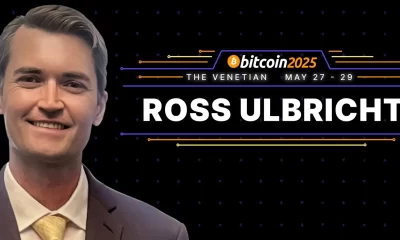Technology
Solana Proposal Promises to Bring Support to Billions of Users
Published
3 months agoon
By
admin

Solana developers have put forward a proposal that could transform how its blockchain handles billions of user accounts, addressing one of the biggest hurdles facing mainstream adoption.
The proposal introduces a “lattice-based” hashing system that fundamentally changes how the blockchain tracks and verifies user account states.
Following approval, the proposal could set a new standard for blockchain scalability, potentially influencing how other networks approach similar scaling challenges.
“The main goal is to scale Solana to billions [of] accounts and compute a “hash of all accounts” in practical time and space,” the proposal reads, outlining a solution to a challenge that has long plagued high-performance blockchains.
Currently, Solana and other blockchains need to recalculate the entire state of all user accounts regularly. However, this process becomes increasingly demanding as the network grows.
The issue has been dubbed the “state growth problem” among blockchain developers. Solana Labs co-founder Anatoly Yakovenko discussed the challenge in May last year.
“The problem comes down to this simple thing: New account creation has to actually create new accounts. Which means that a new account has to prove that it is new somehow,” Yakovenko said.
The Accounts Lattice Hash upgrade eliminates that requirement by enabling instant verification without having to calculate everything again.
The approach borrows from an advanced cryptographic technique called “homomorphic hashing” that allows the network to update its state verification by only processing changed accounts.
With this new system, the same 128-bit security level is maintained while also dramatically reducing computational overhead.
Early implementations of the new system have shown promising results, with two validator clients, Agave and Firedancer, demonstrating its practical viability, according to the proposal’s authors. Decrypt has reached out to the authors and Yakovenko to learn more.
The upgrade will be introduced through Solana’s formal improvement process, requiring network-wide activation through validator voting.
Developers recommend a gradual rollout, allowing nodes to pre-compute the new hashing system before fully activating it.
Edited by Sebastian Sinclair
Daily Debrief Newsletter
Start every day with the top news stories right now, plus original features, a podcast, videos and more.
Source link
You may like


CryptoPunks NFT Sells for $6 Million in Ethereum—At a $10 Million Loss


SEC drops suit against Helium for alleged securities violations


Tokenized Gold Nears $2B Market Cap as Tariff Fears Spark Safe Haven Trade


Ross Ulbricht To Speak At Bitcoin 2025


Solana Eyes $200 Target As It Gains Momentum – Recovery Could Mirror 3-Month Downtrend


BTC-denominated insurance firm meanwhile secures $40m in VC funding
Blockchain
Web3 search engine can reshape the internet’s future
Published
13 hours agoon
April 10, 2025By
admin
Disclosure: The views and opinions expressed here belong solely to the author and do not represent the views and opinions of crypto.news’ editorial.
The internet is at a crossroads. People are continuing to express their frustration and dissatisfaction with the internet—double that of what they felt 20 years ago—as centralized platforms are facing increasing scrutiny for their opaque algorithms, data exploitation, and bias in content curation.
Most online platforms today run on web2, where FAANG companies—Meta, formerly known as Facebook, Amazon, Apple, Netflix, and Alphabet, formerly known as Google—control the data, serve ads, and track users for profit. Users are ultimately the product, and while these companies have added billions in market cap by turning users into the product, this is far from the best model for creating a sustainable knowledge engine like the internet. Participants in the internet ecosystem are starting to wake up to the fact that this model doesn’t really work for anyone except those FAANG companies.
Nowhere are these problems more evident than in search. Search is one of the most fundamental activities on the internet and, thus, stands at the forefront of “gatekept content.” If the internet really is our collective knowledge engine, then search is the first step in acquiring that knowledge.
It is sometimes even the last and only step in using the internet to acquire knowledge, considering that the first result on a Google page has a clickthrough rate of over 25 percent and the tenth result, proportionately, only has a tenth of that. Presumably, a fraction of that fraction even makes it to the second page of results.
Now, consider Google’s prominent position in all of search. Even while Google’s search market share last year dropped below 90 percent for the first time in 10 years, it is still within the range of the popular vote total for a third-world dictator. So, the One True Result that has been served up by Google’s algorithm is getting a quarter of the traffic for the search engine that still holds somewhere in the area of 90 percent of the search engine market share. That’s a lot of opaque and centralized power centered in one private company.
Even while competitors like DuckDuckGo and Bing try to carve out some of their own market share by offering AI-powered search or increased privacy, as centralized companies, they fundamentally present the same problem Google does, without the market share. The integrity of our search results has never been more crucial, and we can’t leave it to web2 structures to be good custodians of that integrity, especially when the priorities of those structures to protect their users can turn on a dime.
The solution is here: Enter web3
How do we put how information is organized back into the hands of users, especially as the search engines promise to become even more inscrutable with the implementation of AI and the obscuring of sources?
One possible way to put that power back into the hands of users is what has thus far been built with web3. Web3 can allow us to build a decentralized, community-powered search engine while participating in a truly open and trustless search ecosystem. A decentralized node-powered ecosystem can ensure fair, unbiased, and censorship-resistant search results, free from the corporate agendas that have shaped traditional search engines.
Instead of relying on corporations, web3 platforms are permissionless, sovereign, and decentralized. They are powered by blockchain and smart contracts instead of centralized corporate servers that open users to vulnerabilities and data insecurity. Web3 gives users control back over their data, identity, and digital assets.
There are a host of other ways in which web3 can empower the user. These include self-sovereignty, permissionless control of assets without fear of confiscation, self-custodial staking and earning, access for the unbanked, peer-to-peer transfers, and, perhaps most important of all, that fundamental decentralization, which eliminates single points of failure while being resistant to manipulation.
There is also no behavioral profiling, no centralized control, and no data tracking. This means no censorship risk, no suppression of competing voices, and a search experience that respects user privacy.
Users must work to reclaim power
Search engines today function as gatekeepers of information, with centralized platforms deciding which content is amplified, suppressed, or monetized based on user profiles and corporate interests. Users deserve a fairer and ultimately better search experience, one where ranking algorithms are not influenced by personal data, past behavior or profit-driven agendas.
The problem is bound to get worse as the AI race heats up and companies look for new data sources on which to train these AIs. Whatever promises a centralized company might have once made to the user about not tracking or using data, again, these priorities can shift very quickly in something like an AI technology realignment. The beauty of web3 is that the structure of the technology itself prevents such exploitation.
Web3 may seem abstract right now, but it’s not all that different from the kind of technical fluency users needed to acquire as they went from the personal computer to the networked personal computer of web2. Users essentially just have to trade out an encrypted password shared with a central web service (and who knows where else) for an encrypted wallet that only they can control and access. The benefits of full control over assets and data will far outweigh whatever stumbling blocks there are to this learning curve.
Users have shown that they are willing to trade a lot for convenience, but perhaps they’ve reached a breaking point in that bargain. Now is the time for web3 to take advantage.

Timothy Enneking
Timothy Enneking is the CEO of Presearch, a decentralized, privacy-focused, web3 search engine. He was initially invited to join the project seven years ago after he recommended it during a CNBC Asia interview on crypto, and he remained an advisor for four years. He rejoined Presearch in August 2023 when the founder invited him to become the CEO and bring the project to the next level. He is the founder and Principal of Digital Capital Management, LLC (“DCM”), which runs CAF 2017, a crypto trading fund. He is also the founder and managing partner of Psalion, which manages two venture capital funds and a yield farming operation. For nine years ending in June 2024, Mr. Enneking was the Chief Investment Officer of Mana Companies Asset Management, a medium-sized family office (which did not invest in crypto). Prior to those activities, Mr. Enneking founded and managed Tera Capital Fund, a fund of funds focused on Eastern Europe (established in 2004). Simultaneously, in 2013, he was engaged to manage the world’s first Bitcoin fund. Mr. Enneking also has extensive M&A experience, having completed more than 70 transactions with an aggregate transaction value of over US$12 billion. He speaks near-native French and Russian, as well as German. He has five university degrees, all in international business and law.
Source link

Disclosure: The views and opinions expressed here belong solely to the author and do not represent the views and opinions of crypto.news’ editorial.
AI-generated avatars and virtual assistants will revolutionize our digital landscape, powering virtual influencers, workplace stand-ins, and immersive metaverse experiences. Yet, beneath this technological marvel lies a pressing question: who truly owns and controls your digital identity? The reality is stark—most AI avatars are tethered to centralized platforms where corporations hold dominion, exposing users to exploitation, financial fraud, and a profound loss of autonomy. As these digital personas become integral to our virtual lives, the need for a transformative solution has never been more urgent.
Decentralizing AI avatars through blockchain technology and smart contracts emerges as a vital antidote, promising to restore control to individuals in an increasingly virtualized world. The dangers of centralized systems are vividly demonstrated by high-profile abuses that have shaken public trust. In January 2024, a deepfake robocall mimicking U.S. President Joe Biden targeted New Hampshire voters, falsely urging Democrats to skip the primary in a bid to sway the 2024 election. This brazen act of manipulation, which prompted an FCC ruling to ban deepfake robocalls and ignited debates over AI regulation, exposed the fragility of centralized platforms that harbor the data fueling such scams.
The entertainment industry offers another stark warning. In early 2024, explicit deepfake images of Taylor Swift flooded social media, amassing over 45 million views before removal after a 17-hour delay. This incident laid bare the limitations of centralized content moderation, which often falters under pressure, leaving women and public figures disproportionately vulnerable to digital harm. The fallout was swift—Swift’s team condemned the breach, and platforms scrambled to respond, yet the delay highlighted a systemic failure to protect digital likenesses in real-time.
Additionally, Meta’s Oversight Board recently took up cases involving deepfake explicit imageries, noting inconsistent moderation practices— certain content was removed faster than others due to not passing specific community guidelines, highlighting inequities in centralized systems. These examples show how centralized avatar management leaves users powerless and unable to prevent misuse of their digital likeness.
Why AI avatars need to be decentralized
Centralized platforms trap users in ecosystems where their digital identities are subject to exploitation or sudden deactivation at corporate whim. This unchecked dominance shatters the vision of a user-empowered digital future, reducing individuals to mere cogs in a profit-driven machine. Decentralization flips this narrative, fostering self-sovereign identity where users hold the reins, owning and managing their avatars with confidence.
By placing control in the hands of individuals, decentralized systems can curb corporate overreach, ensuring AI avatars reflect their creators’ intent rather than serve as tools for exploitation.
Blockchain-powered AI ownership
Blockchain technology stands as a beacon of hope against these escalating threats. Through on-chain verification, it forges an unalterable record of avatar ownership, forging a secure bond between digital identities and their rightful owners while decisively countering unauthorized deepfake abuse.
This was painfully evident in February 2023, when a French interior designer fell pray in a romance scam: fraudsters wielded AI-generated images and messages to impersonate Brad Pitt, spinning a tale of a fabricated relationship and a fabricated cancer diagnosis that convinced her to part with €830,000—her life savings—before the deception unraveled. Such episodes unveil the dangers of centralized platforms, which hoard user data and become fertile ground for AI-driven fraud, eroding trust and inflicting devastating personal losses. Without a verifiable system to authenticate digital identities, AI-driven deception will only intensify. Users are left defenseless as deepfakes become more sophisticated and harder to detect. The challenge is clear: How can we secure digital avatars against misuse while ensuring individuals, not corporations, maintain control over their online presence?
Yet, blockchain’s potential extends further. Smart contracts bolster this framework by automating rights management, guaranteeing avatars operate with unwavering security and transparency while fortifying defenses against fraud. This comprehensive approach not only shields digital assets from theft but also alleviates the ethical and legal burdens intensified by centralized oversight, equipping users with verifiable dominion over their virtual selves.
A web3 future for AI avatars
Decentralized AI avatars can also drive a vibrant web3 economy, integrating into metaverses, digital workspaces, and decentralized social networks. These avatars can become dynamic assets—representing users in virtual worlds, facilitating remote collaboration, or enabling secure interactions online. Picture a musician selling a unique avatar on a decentralized marketplace or a professional using a blockchain-verified digital twin to authenticate their presence in a virtual meeting. This ecosystem thrives on user ownership, positioning decentralized AI avatars as a foundation for the next digital economy.
The drive to decentralize AI avatars is non-negotiable—centralized systems, exposed by explosive deepfake scandals and crumbling moderation, threaten to dismantle safety and freedom in an AI-drenched world. Blockchain carves a decisive path to empowerment, handing the reins of digital identity back to individuals, not corporate overlords. The clock is ticking: seize control of your digital destiny now, or watch it vanish into a dystopian abyss of corporate domination.

Roman Cyganov
Roman Cyganov is the founder and CEO of Antix, a company at the forefront of web3, AI, and gaming technologies. Recognized by OUTPUT as one of the Top 10 Global Talents, Roman has a rich history of driving technological innovation and redefining how businesses engage with digital audiences. Under his leadership, Antix has developed AIGE, a cutting-edge technology that crafts hyper-realistic AI-powered digital humans, revolutionizing client interactions in the digital space. Roman’s entrepreneurial journey includes co-founding VIVIX Inc., where he served as CCO before his pivotal role at Antix. His career is marked by a successful exit and numerous high-profile ventures that underscore his role as a serial entrepreneur leading the next wave of digital transformation.
Source link
Bitcoin
BTCFi: From passive asset to financial powerhouse?
Published
2 weeks agoon
March 30, 2025By
admin
Disclosure: The views and opinions expressed here belong solely to the author and do not represent the views and opinions of crypto.news’ editorial.
Bitcoin (BTC) has always been the face of crypto, the first thing that comes to mind when you think of this market. But for years, its role has been largely static—held as a store of value, yet rarely used for anything else. Then BTCFi entered the scene: unlike traditional DeFi, which has been dominated by Ethereum (ETH) and other smart contract platforms, BTCFi is built around Bitcoin as the core asset.
In the last quarter of 2024, BTCFi’s total value saw a massive surge—from $800 million all the way to $6.5 billion. The momentum is impressive, to say the least. More institutional players are taking notice, and analysts predict that by 2030, roughly 2.3% of Bitcoin’s circulating supply (about $47 billion) could be actively used in decentralized finance.
So clearly, BTCFi is not just a passing trend. But why is it gaining so much traction? Can it really be called the future of Bitcoin’s utility as a financial asset?
Let’s try to figure it out.
What is BTCFi, and why is it growing now?
BTCFi represents the intersection of Bitcoin and decentralized finance, with the first crypto playing the role of the core asset in this case. Typically, DeFi platforms have been built on blockchains like Ethereum, while Bitcoin holders had to wrap their BTC into ERC-20 tokens (like wBTC) to participate in this field.
This kind of tokenization started picking up the pace around 2020, allowing BTC holders to access DeFi services that are typically not available on the Bitcoin blockchain. These “wrapped” tokens are built in a way that makes them compatible with other blockchain networks. And so, they effectively extended Bitcoin’s functionality.
However, advancements in Bitcoin L2 solutions and LRTs, or layered rollup technologies, are now changing the rules. It is becoming unnecessary for Bitcoin to use “second class citizen” ERC-20 tokens anymore.
BTC LRTs, for example, operate on Ethereum and other chains as well, but use Bitcoin as the primary collateral in transactions. This means unlocking the use of Bitcoin as a yield-generating asset in other networks beyond its native chain.
The emerging Bitcoin L2s, meanwhile, are tackling this blockchain’s long-standing scalability issues, allowing for faster and more cost-efficient transactions. These innovations are going to fundamentally redefine Bitcoin, turning it from a passive store of value to an actively utilized financial asset.
Why is BTCFi the gateway for Bitcoin whales in 2025?
Large Bitcoin holders—miners, in particular—have often used CeFi loans backed by their BTCs to fund their operations since they didn’t want to outright sell those assets. This practice is still going on today, but BTCFi promises to make some changes. And that’s where everything will start from, really: by BTCFi enabling new opportunities for Bitcoin holders to put their assets to work.
Soon enough, Bitcoin whales will start looking at BTCFi as a powerful gateway that can be used to enter the DeFi space. And the way I see it, there are two key factors in 2025 that will influence that perception.
The first is the rise of Bitcoin ETFs. BTC ETFs currently account for almost 6% of all Bitcoin supply, having crossed $100 billion in holdings at the beginning of 2025. With them gaining mainstream traction, Bitcoin is increasingly perceived as the safest and most stable cryptocurrency asset.
This makes it a prime choice for DeFi, attracting large-scale holders who want to use their BTC without selling. Earlier in February this year, Goldman Sachs announced that it had invested $1.63 billion in Bitcoin ETFs. That’s easy proof right there.
The second major factor is the appearance of BTC L2 technologies, which we’ve already covered earlier. Until recently, the lack of scalability and transaction efficiency held Bitcoin back from DeFi adoption. Now, we are going to see a surge of L2 solutions that will enhance the network’s performance. And here’s the important part: they will do so while preserving Bitcoin’s core principles of decentralization and simplicity (and, hence, its robustness).
What DeFi platforms need to do for proper BTCFi integration
There are several challenges that will need to be overcome before BTCFi can achieve truly seamless integration. The biggest technical issue will be ensuring that Bitcoin-based L2 solutions become genuinely trustless. At the present time, they are not quite there, often relying on intermediaries and centralized elements, which goes against Bitcoin’s core philosophy.
The good news is that there’s a lot of R&D going on to make it happen. If successful, it could make the vast amounts of BTCs that are currently just lying there “collecting dust” be useful in DeFi.
Another big challenge is going to stem from people’s trust. Among Bitcoin holders, there are many who do not quite trust Ethereum and the existing Bitcoin tokenization methods. The key to winning them over will lie in creating robust and cost-effective solutions on the native Bitcoin network. Having a fully trustless and inexpensive execution layer on the BTC blockchain could really become the dealbreaker for these people.
The future of Bitcoin: More than just ‘digital gold’
For years, Bitcoin has been carrying the moniker of “digital gold”—a safe-haven asset meant for holding rather than using. These days, this is becoming increasingly untrue. As more institutional players enter the crypto space, the potential for BTCFi to become Bitcoin’s next-level evolution is very real.
The demand is on the rise, and the infrastructure is already being built. For Bitcoin whales looking to maximize their assets without selling, BTCFi could become the perfect answer.
Disclosure: This article does not represent investment advice. The content and materials featured on this page are for educational purposes only.

Michael Egorov
Michael Egorov is a physicist, entrepreneur, and crypto maximalist who stood at the origins of DeFi creation. He is a founder of Curve Finance, a decentralized exchange designed for efficient and low-slippage trading of stablecoins. Since the inception of Curve Finance in 2020, Michael has developed all his solutions and products independently. His extensive scientific experience in physics, software engineering, and cryptography aids him in product creation. Today, Curve Finance is one of the top three DeFi exchanges regarding the total volume of funds locked in smart contracts.
Source link

CryptoPunks NFT Sells for $6 Million in Ethereum—At a $10 Million Loss

SEC drops suit against Helium for alleged securities violations

Tokenized Gold Nears $2B Market Cap as Tariff Fears Spark Safe Haven Trade

Ross Ulbricht To Speak At Bitcoin 2025

Solana Eyes $200 Target As It Gains Momentum – Recovery Could Mirror 3-Month Downtrend

BTC-denominated insurance firm meanwhile secures $40m in VC funding

‘You Want To Own the Most Hated Thing’ – Arthur Hayes Says Ethereum Set To Outrun Solana As Memecoin Craze Fades

Crypto Braces for a Hidden $4.5 Trillion Catalyst for Bitcoin, Ethereum, Cardano, XRP Price

Block Agrees to $40M NYDFS Penalty Over Lackluster Compliance Program

Top Bitcoin miners produced nearly $800M of BTC in Q1 2025

Tariffs, Trade Tensions May Be Positive for Bitcoin (BTC) Adoption in Medium Term: Grayscale

The U.S. Tariff War With China Is Good For Bitcoin Mining

Dogecoin Bull Div Plays Out, Analyst Maps Next Price Targets

Web3 search engine can reshape the internet’s future

Billionaire Ray Dalio Says He’s ‘Very Concerned’ About Trump Tariffs, Predicts Worldwide Economic Slowdown

Arthur Hayes, Murad’s Prediction For Meme Coins, AI & DeFi Coins For 2025

Expert Sees Bitcoin Dipping To $50K While Bullish Signs Persist

Aptos Leverages Chainlink To Enhance Scalability and Data Access

Bitcoin Could Rally to $80,000 on the Eve of US Elections

Crypto’s Big Trump Gamble Is Risky

Sonic Now ‘Golden Standard’ of Layer-2s After Scaling Transactions to 16,000+ per Second, Says Andre Cronje

Institutional Investors Go All In on Crypto as 57% Plan to Boost Allocations as Bull Run Heats Up, Sygnum Survey Reveals

Ripple-SEC Case Ends, But These 3 Rivals Could Jump 500x

Has The Bitcoin Price Already Peaked?

A16z-backed Espresso announces mainnet launch of core product

The Future of Bitcoin: Scaling, Institutional Adoption, and Strategic Reserves with Rich Rines

Xmas Altcoin Rally Insights by BNM Agent I

Blockchain groups challenge new broker reporting rule

I’m Grateful for Trump’s Embrace of Bitcoin

Trump’s Coin Is About As Revolutionary As OneCoin
Trending

 24/7 Cryptocurrency News5 months ago
24/7 Cryptocurrency News5 months agoArthur Hayes, Murad’s Prediction For Meme Coins, AI & DeFi Coins For 2025

 Bitcoin3 months ago
Bitcoin3 months agoExpert Sees Bitcoin Dipping To $50K While Bullish Signs Persist

 24/7 Cryptocurrency News3 months ago
24/7 Cryptocurrency News3 months agoAptos Leverages Chainlink To Enhance Scalability and Data Access

 Bitcoin5 months ago
Bitcoin5 months agoBitcoin Could Rally to $80,000 on the Eve of US Elections

 Opinion5 months ago
Opinion5 months agoCrypto’s Big Trump Gamble Is Risky

 Altcoins2 months ago
Altcoins2 months agoSonic Now ‘Golden Standard’ of Layer-2s After Scaling Transactions to 16,000+ per Second, Says Andre Cronje

 Bitcoin5 months ago
Bitcoin5 months agoInstitutional Investors Go All In on Crypto as 57% Plan to Boost Allocations as Bull Run Heats Up, Sygnum Survey Reveals

 Price analysis5 months ago
Price analysis5 months agoRipple-SEC Case Ends, But These 3 Rivals Could Jump 500x


